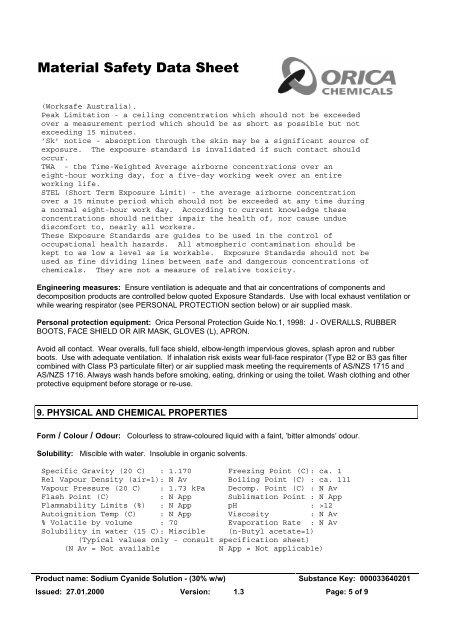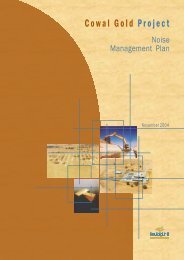January 2006 (PDF 2.9 MB) - Barrick Gold Corporation
January 2006 (PDF 2.9 MB) - Barrick Gold Corporation
January 2006 (PDF 2.9 MB) - Barrick Gold Corporation
Create successful ePaper yourself
Turn your PDF publications into a flip-book with our unique Google optimized e-Paper software.
0DWHULDO 6DIHW\ 'DWD 6KHHW<br />
(Worksafe Australia).<br />
Peak Limitation - a ceiling concentration which should not be exceeded<br />
over a measurement period which should be as short as possible but not<br />
exceeding 15 minutes.<br />
’Sk’ notice - absorption through the skin may be a significant source of<br />
exposure. The exposure standard is invalidated if such contact should<br />
occur.<br />
TWA - the Time-Weighted Average airborne concentrations over an<br />
eight-hour working day, for a five-day working week over an entire<br />
working life.<br />
STEL (Short Term Exposure Limit) - the average airborne concentration<br />
over a 15 minute period which should not be exceeded at any time during<br />
a normal eight-hour work day. According to current knowledge these<br />
concentrations should neither impair the health of, nor cause undue<br />
discomfort to, nearly all workers.<br />
These Exposure Standards are guides to be used in the control of<br />
occupational health hazards. All atmospheric contamination should be<br />
kept to as low a level as is workable. Exposure Standards should not be<br />
used as fine dividing lines between safe and dangerous concentrations of<br />
chemicals. They are not a measure of relative toxicity.<br />
Engineering measures: Ensure ventilation is adequate and that air concentrations of components and<br />
decomposition products are controlled below quoted Exposure Standards. Use with local exhaust ventilation or<br />
while wearing respirator (see PERSONAL PROTECTION section below) or air supplied mask.<br />
Personal protection equipment: Orica Personal Protection Guide No.1, 1998: J - OVERALLS, RUBBER<br />
BOOTS, FACE SHIELD OR AIR MASK, GLOVES (L), APRON.<br />
Avoid all contact. Wear overalls, full face shield, elbow-length impervious gloves, splash apron and rubber<br />
boots. Use with adequate ventilation. If inhalation risk exists wear full-face respirator (Type B2 or B3 gas filter<br />
combined with Class P3 particulate filter) or air supplied mask meeting the requirements of AS/NZS 1715 and<br />
AS/NZS 1716. Always wash hands before smoking, eating, drinking or using the toilet. Wash clothing and other<br />
protective equipment before storage or re-use.<br />
9. PHYSICAL AND CHEMICAL PROPERTIES<br />
Form / Colour / Odour: Colourless to straw-coloured liquid with a faint, ’bitter almonds’ odour.<br />
Solubility: Miscible with water. Insoluble in organic solvents.<br />
Specific Gravity (20 C) : 1.170 Freezing Point (C): ca. 1<br />
Rel Vapour Density (air=1): N Av Boiling Point (C) : ca. 111<br />
Vapour Pressure (20 C) : 1.73 kPa Decomp. Point (C) : N Av<br />
Flash Point (C) : N App Sublimation Point : N App<br />
Flammability Limits (%) : N App pH : >12<br />
Autoignition Temp (C) : N App Viscosity : N Av<br />
% Volatile by volume : 70 Evaporation Rate : N Av<br />
Solubility in water (15 C): Miscible (n-Butyl acetate=1)<br />
(Typical values only - consult specification sheet)<br />
(N Av = Not available N App = Not applicable)<br />
Product name: Sodium Cyanide Solution - (30% w/w) Substance Key: 000033640201<br />
Issued: 27.01.2000 Version: 1.3 Page: 5 of 9

















